Introduction
The well-drained savannas of Eastern Colombia cover 4.5 M ha and extend to the right of the Meta River until it discharges into the Orinoco River. Soils are Oxisols, typic Haplustox, containing kaolinitic clays with high concentrations of Al, low concentrations of P and cations, and low concentration and quality of organic matter (IGAC 1995). Deep soils are easily cultivated, but can seal and compact rapidly, diminishing water infiltration rates (Amézquita et al. 1998; Hoyos et al. 1999). The native savannas have traditionally been used for extensive cow-calf systems (Van Ausdal 2009), but production systems have evolved and diversified over the last few decades with the introduction of crops and sown pastures (Valencia and Leal 2004; Amézquita et al. 2013). Tropical grass pastures are generally established after removing the native vegetation but the development of adapted upland rice varieties, and later maize cultivars, allowed the undersowing of pastures with these cereals, thereby reducing establishment costs and taking advantage of residual crop fertilizer. While regular rotations of pastures with rice or maize were expected to develop economically viable and sustainable agropastoral systems (Sanz et al. 2004), producers have to change a culture dominated by extensive cattle ranching to more intensive crop-livestock systems. Various extension initiatives over the last 30 years gave rise to a variety of pastures established with one or more of the above systems, ranging from low external input, directly drilled pastures, to relatively high-input systems using rice or maize undersown with the same grass species or with more demanding species. These initiatives largely concentrated on the more levelled areas of the savannas (’Altillanura plana’; high savannas) and in a few cases, on valleys of the undulating, dissected savannas (’Serranía’).
The primary objective of the current work was to compile, systematize and analyze the information available on beef production based on tropical sown (‘improved’) pastures established with different methods and compare it with production from native range-lands in the high savannas of the Colombian Eastern Plains. Secondly, we aimed to establish the magnitude of differences in beef output, their ranges and variability, and also to broadly assess the effects of soil and management on performance, if any. The underlying hypothesis was that long-term and practically relevant differences between systems would be found, and based on the authors’ experience, differences in production between lighter and heavier soil textures were expected.
Materials and Methods
Location
The study region is located in the municipalities of Puerto López and Puerto Gaitán (3°55' and 4°20' N, 72°1' to 72°5' W; 120‒220 masl), Meta Department, Colombia. Mean annual temperature is 26 °C with little variation throughout the year. Average annual rainfall is 2,649 and 2,158 mm for Puerto López and Puerto Gaitán, respectively, concentrated during April‒November. Potential evapotranspiration amounts to 112 mm/month, and mean solar radiation is 4.47 kw-h/m2 (HIMAT 1994).
Database
Data for control native savanna paddocks (Sav) and 3 contrasting and common pasture establishment methods (System), including direct drilling of pasture (Grass) after savanna, pasture undersown with an upland rice crop (Rgrass) and pasture undersown with a maize crop (Mgrass), were collected and contrasted. Adapted cultivars of both annual crops (Valencia and Leal 2004) were used in all cases. The systems varied in terms of land preparation practices and fertilizer application and are described by Sanz et al. (2004) and Rincón and Flórez (2013). In general, Grass systems implied seeding of the pasture species after savanna, with low levels of fertilizer application, including 20 kg P, 20 kg K, 100 kg Ca, 20 kg Mg and 10 kg S/ha; Rgrass systems consisted of the joint planting of upland rice and pasture species following recommended practices (Sanz et al. 2004), including dolomitic limestone (90 kg Ca and 27 kg Mg/ha), 50 kg P, 100 kg K and 5 kg Zn/ha; and the Mgrass system involved undersowing pasture species with a maize crop with much higher fertilizer inputs. The data for 4 farms reported by Rincón and Flórez (2013) represented maize-pasture combinations that received dolomitic lime (550 kg Ca and 225 kg Mg/ha), 1,000 kg rock phosphate and 400 kg gypsum/ha; the maize crop received in addition 128 kg N and 120 kg P (40 kg soluble, 80 kg as rock phosphate)/ha. An additional farm (Hoyos and Vera, unpublished) grew drilled maize undersown with B. decumbens fertilized with dolomitic limestone (330 kg Ca and 135 kg Mg), 80 kg N, 50 kg P, 100 kg K and 20 kg Zn/ha.
Sown grass species included Andropogon gayanus (Ag, cv. Carimagua 1) and commercial Brachiaria humidicola (Bh, CIAT 679) for the Grass system; Brachiaria dictyoneura (Bdic, cv. Llanero; reclassified as B. humidicola,Cook and Schultze-Kraft 2015) in the Grass and Rgrass systems, and hybrid Brachiaria cv. Mulato II and Brachiaria brizantha cv. Toledo in the Mgrass system. These grass species were generally associated with a variety of legumes that over the long term made a low contribution to botanical composition and are not further considered here. Initial analyses indicated that differences between systems were larger than between grass species within systems, and the present paper focusses on the former, independently of the grass species sown.
A database of steer liveweight gains in relation to System was compiled and included published peer-reviewed papers, institutional bulletins and conference proceedings between the years 1979 and 2016, but 70% of the data originated from a large number of unpublished on-farm recordings made by the authors. The total number of individual records was 198 for 17 farms and paddock sizes varied between 100 and 250 ha in the case of savannas, and between 10 and 80 ha for sown species; number of animals per paddock ranged between 15 and 90 head per year. In all cases, animals were replaced annually. Not all animals were present throughout a year in the respective paddocks given changes brought about by sales, purchases and other management decisions taken by graziers, so that weighted averages were used when necessary.
Relatively small, intensively-managed, grazing plot experiments run at the regional Research Center Carimagua (CORPOICA) were not included, and served as controls for the subsequent discussion. The number and types of records available are summarized in Table 3. The final version of the database was thoroughly checked for consistency and errors.
Definition of variables and production systems
The following variables were recorded: year sown; year observed; pasture age (years); soil texture; soil apparent density (apdensity); species and cultivars sown; stocking rates during wet and dry seasons (SRw and SRd, respectively, in head/ha); daily liveweight gains during the wet and dry seasons (DLWGw and DLWGd in g/head); liveweight gains during the respective seasons (LWGw and LWGd in kg/head); yearly liveweight gain (LWGhayr in kg/ha); and production system (System). Live weights of grazing beef cattle (yearlings and steers) were recorded 3 or 4 times during the wet season and at least twice in the dry season, to allow calculation of daily liveweight changes in both seasons. A further dummy variable, ‘dummymgmt’, was defined based on the decision-making process regarding establishment and management of the system such that a value of -1 was assigned to researcher-led processes, 0 to joint farmer-researcher management decisions and +1 to solely farmer decision making. Soil samples were generally taken at the time of planting and at 0‒20 cm depth. More detailed data on soil texture and apparent density were evaluated on the same ranches as well as on others, and are discussed at length by Hoyos et al. (1999) and Rivas et al. (2004).
For simplicity of presentation, and in view of large between-farms variability, subsequent analyses grouped wet season stocking rates into 4 discrete categories (very low = <0.5; low = 0.5 to <1.50; medium = 1.5 to <3.0; and high = ≥3 animals/ha). Similarly, pasture age was grouped into 3 categories (low = 2 or less; medium = >2 and <6; and high = 6 years and greater).
Lengths of wet and dry seasons were standardized to 210 and 155 days, respectively, based on a large volume of existing climate data for the Altillanura (Hoyos et al. 1999). Available data on beef production referred to pastures ranging in age between 1 and 15 years, but not every age was available for every paddock such that grazing data in individual paddocks extended to a maximum of 7 years. A small number of records did not include dry season performance, most frequently because pastures were rarely used in that season or due to other management issues.
Statistical analyses
All statistical analyses were carried out with SAS/STAT 9.2 (SAS 2009).
Initial analyses involved the calculation of descriptive statistics for the available quantitative variables (Table 2), verification of the distributional properties of the data and extensive graphical analyses. Canonical discriminant analyses (proc CANDISC) were carried out to establish orthogonal canonical variables that best discriminate between production systems. The primary goal of the discriminant analyses was to “find the dimension or dimensions along which groups differ, and to find classificatory functions to predict group membership” (Tabachnick and Fidell 2007).
Table 1 Soil texture and chemical composition (0‒20 cm) across a range of farms and pastures. SOM = soil organic matter.

Table 2 Descriptive statistics of variables monitored in farm paddocks: DLWG = daily liveweight gain during wet and dry seasons; SR = stocking rate during the specified season; LWG = liveweight gain/head during the specified season or year; and LWGha = liveweight gain/ha during the season or per year.
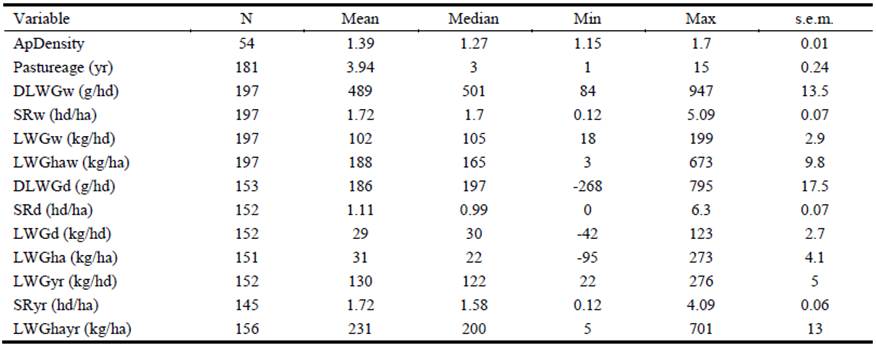
Factors selected for the analyses included the following: dummymgmt, apdensity, year observed, DLWGw, DLWGd, SRw, SRd, LWGhaw and LWGhad. The number of canonical variables selected was based on their significance, but was restricted to a maximum of 3, and Mahalanobis square distances were assessed to determine distances between production systems. Preliminary analyses of variance and stepwise linear regressions were also used to select categorical and quantitative variables used in the final analyses.
Definitive analyses were based on fitting generalized linear mixed models (GLMM) using proc GLIMMIX (Gbur et al. 2012) to data, including the following factors: farm as random variable; System as categorical variable; SRw (or discrete stocking rates as previously described), pastureage (or discrete age), soil organic matter, clay and sand %, and soil P, Ca, Mg and K concentrations as quantitative variables; and lastly the interactions of pastureage × SRw and pastureage × System. Numerous other interactions were tested and discarded due to very low probability values. The final GLMM model included the following factors: farm as random variable, System, SRw, pastureage × System and pastureage × SRw, since these variables were significant, but when comparing treatments, preference was given to standard errors of the mean (s.e.m.) and confidence intervals (CI) in view of current discussions on the value and interpretation of P values (Wasserstein and Lazar 2016).
Results
Statistics of the database
Descriptive statistics for the available farm data are shown in Table 2, while Table 3 groups statistics based on the previously described System.
Table 3 Descriptive statistics of main variables monitored in farm paddocks according to system of pasture establishment (System): Grass = conventional drilling of pasture after savanna; Rgrass = pasture undersown with rainfed rice crop; Mgrass = pasture undersown with maize crop; and Sav = native savanna. N = number of observations over the duration of the recording process; DLWG = daily liveweight gain during the wet or dry season; SR = stocking rate during the specified season or whole year; LWGhayr = liveweight gain/ha during the year.
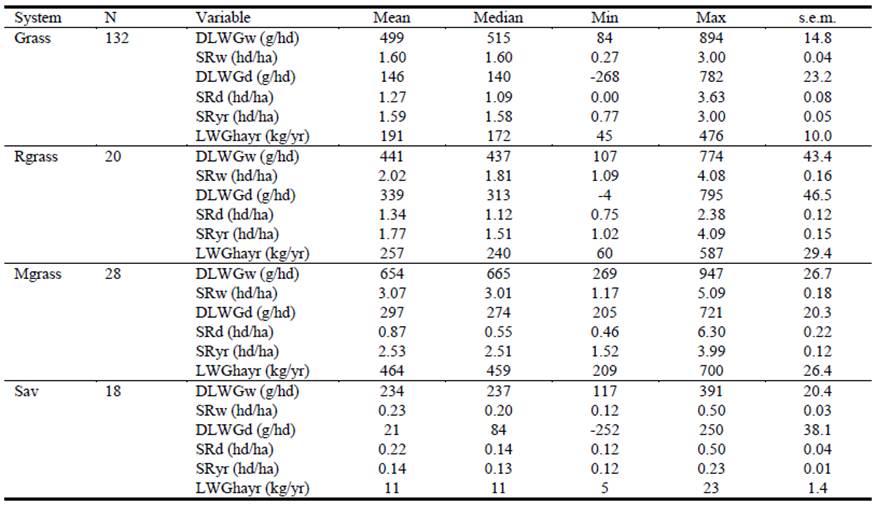
Canonical discrimination
Canonical analyses identified 3 distinct canonical variables that were partially successful in separating Systems from one another, when restricted to observations made during the wet season and during the whole year. The results of these analyses guided subsequent analyses of variance. The first 2 canonical variables (Figure 1) accounted for 97.1 and 97.8% of the variance (P<0.0001) for all multivariate statistical tests (e.g. Wilks’ Lambda, Pillai’s trace) for analyses which referred to the wet season and the whole year, respectively. In both cases, the first canonical variable, which accounted for 75.5 and 75.3% of the variance, respectively (P<0.0001), was dominated by the effects of SRw, SRd and pastureage, indicating the major influence of these variables on performance of the various systems.
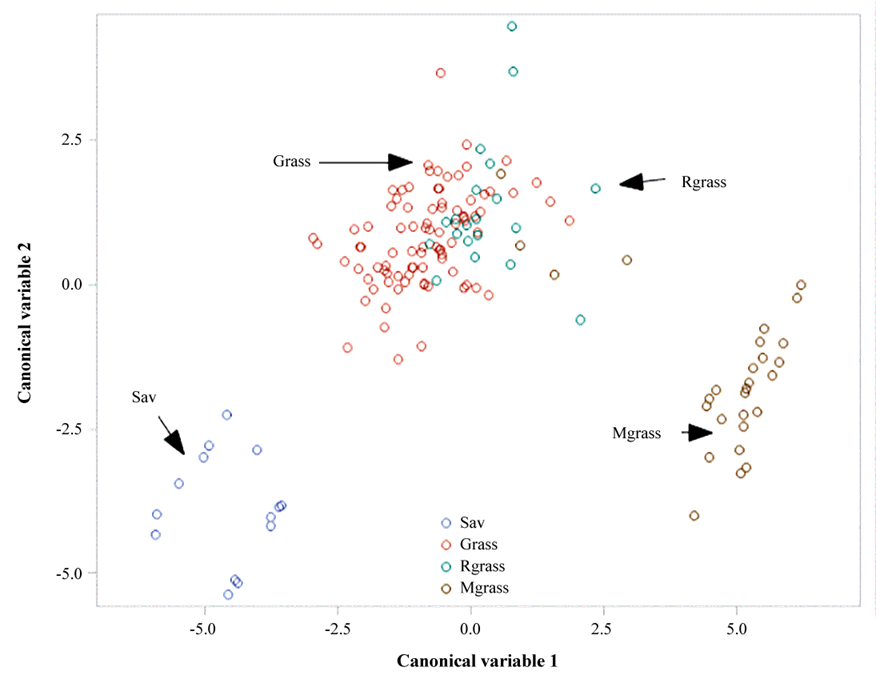
Figure 1 Plot of the first 2 canonical variables showing the separation between production systems achieved by canonical discrimination. Further details in text.
These 2 canonical variables successfully discriminated between the 2 extreme Systems, namely Sav and Mgrass, as shown in Figure 1, whereas the remaining 2 systems overlapped, making further separation impossible. In fact, the Mahalanobis square distances between Grass and Rgrass were very small, although significant, for both analyses.
The loadings or canonical structures equivalent to the correlations between the original and the canonical variables for pastureage, SRw, LWGhaw and DLWGw were 0.92, 0.81, 0.78 and 0.56, respectively, for the first canonical variable, indicating the importance of the original variables in determining the structure of the database, whereas soil texture and apparent density had very small correlations.
Influential effects
On-farm grazing management of sown pastures consisted of some measure of rotational grazing, varying in the length of the grazing/spelling periods, whereas savanna paddocks were generally subject to continuous grazing.
Animal performance was largely determined by performance during the wet season so further analyses of the database focused mainly on that season. Initial analysis with a full model including all experimental factors showed that, contrary to the initial hypothesis of the authors, soil texture (P = 0.39), soil apparent density (P = 0.29) and dummymgmt (P = 0.48) did not influence liveweight gain/hd during the wet season. A similar non-significant result was observed for liveweight gain/ha during the wet season, so these 3 variables were excluded from subsequent analyses. On the other hand, pasture age, stocking rate during the wet season, and several interactions among them consistently had significant effects (P values at least <0.01 in all cases) as discussed below.
Animal performance
Mean (Least square means, LSMEANS) long-term weight gains for the 3 sown pasture systems (System) are shown in Table 4. Gains on Grass and Rgrass systems were similar (P>0.05) during the wet season or whole year, and were significantly (P<0.01) lower than those on Mgrass, the differences being of practical relevance. The performance of Rgrass during the dry season following the rice harvest was unexpectedly higher than that of the other 2 systems and this effect carried over into longer-term analyses.
Table 4 Long-term mean liveweight gains (kg/ha) per season and per year for 3 systems of pasture establishment (System): Grass = conventional drilling of pasture after savanna; Rgrass = pasture undersown with rainfed rice crop; Mgrass = pasture undersown with maize crop. Data consist of least square means (LSMEANS) followed by the respective standard errors and confidence intervals (P = 0.05; in parentheses).
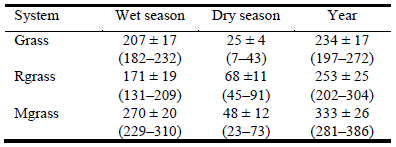
Throughout all analyses, the effects of stocking rate and pasture age were very consistent and significant (P<0.0001). Wide dispersion and variability of the above parameters were present in the database and for purposes of summarizing, ages of pastures and stocking rates were grouped into discrete categories as previously described. The most relevant and significant LSMEANS for the respective parameters are summarized in Tables 5 and 6. The breakdown of these 2 tables indicates clearly the relative abundance of observations for the various combinations of systems and variables, some of which are absent or not plausible, and where the number of observations is low, the LSMEANS should be viewed only as indicative of possible trends.
Table 5 Effects of stocking rate (head/ha) on animal performance from 4 contrasting systems: Grass = conventional drilling of pasture after savanna; Rgrass = pasture undersown with rainfed rice crop; Mgrass = pasture undersown with maize crop; and Sav = native savanna. Data consist of least square means (LSMEANS) ± standard errors where appropriate. Empty table cells indicate data not available. N = number of records; SRw = stocking rate during the wet season; DLWGw = daily liveweight gain during the wet season; and LWGha = liveweight gain/ha/year.
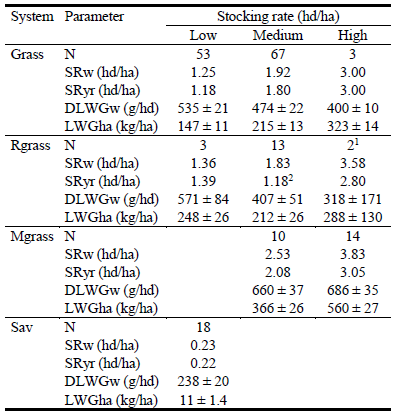
1 Caution is required in interpreting the values in this section.
2 The low annual SR compared with that of the wet season was due to pastures left ungrazed during the dry season.
Table 6 Effects of pasture age (years) on animal performance from 4 contrasting systems: Grass = conventional drilling of pasture after savanna; Rgrass = pasture undersown with rainfed rice crop; Mgrass = pasture undersown with maize crop; Sav = native savanna. Data consist of least square means (LSMEANS) ± standard errors where appropriate. Empty table cells indicate data not available. N = number of observations; SRyr = stocking rate during the whole year; DLWGw = daily liveweight gain during wet season; and LWGhayr = liveweight gain/ha during the year.
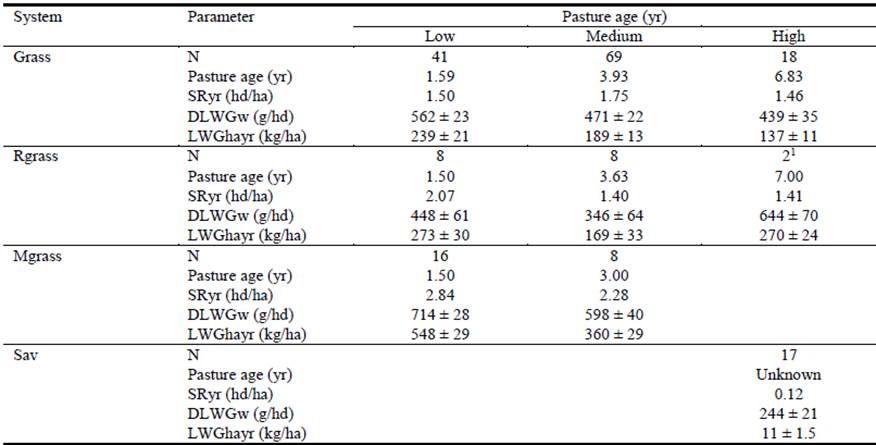
1 Caution is required in interpreting the values in this section.
The rate of change of DLWGw with increasing age of pasture was significantly steeper (P<0.01) in Mgrass than in the other 2 systems that did not differ from each other. Similar regressions of DLWGw on stocking rate yielded parallel lines between the 3 systems (not shown), with a significant difference between Mgrass and the other 2 systems. The magnitudes of these differences were of practical relevance and are illustrated in Tables 5 and 6. Within years and over the long term, dry season performance did not differ between systems (P>0.05) and there was no influence of any of the experimental factors.
As indicated above, there were significant (P<0.001) interactions between System and discrete age, as well as between System and discrete SRw. Weight gains per ha and per year increased steeply in Mgrass (Table 5) with increase in stocking rate and significantly less so in Grass and Rgrass. On the other hand, the negative effect of age on annual output per ha was significantly more pronounced in Mgrass than in the other 2 systems.
Discussion
Until a few decades ago, the Eastern Plains of Colombia were considered marginal lands (Rausch 2013) but discovery of valuable oil resources, development of appropriate agricultural technologies, ingress of large investors and continued increase in demand for land and food production have made the region a significant link in valuable food, feed and oil production chains. Furthermore, lands previously regarded as fit only for very extensive cattle systems are increasingly in demand for new crops, conservation of land and biodiversity and as reserves for original peoples and cultures (Navas-Ríos 1996; Boron et al. 2016), but beef cattle production still constitutes the main land use system of the region.
Information regarding weight gains by unsupplemented stockers and steers grazing tropical pasture species in the savannas of Eastern Colombia is available from the mid-1970s until the present time and is widely dispersed among a few peer-reviewed journal papers, numerous institutional publications of varying circulation and unpublished databases. Pasture species have been established using 3 main seeding methods, including: conventional drilling after removing native savanna species along with a low level of P fertilizer occasionally complemented with Ca and K; undersown with upland rice with recommended soil preparation methods and application of fertilizers (Sanz et al. 2004); and undersown with maize using a more complex system of land preparation and higher external inputs (Rincón and Flórez 2013). With regard to soil nutrient status, Hoyos et al. (1992a) conducted an extensive and detailed survey of on-ranch soil properties and reported large variations in soil texture, and strong and significant relationships between soil texture and nutrient concentrations, factors that would contribute to increased variability in any comparison between sites.
Soils supporting these pastures are generally nutrient-deficient and deep, and originally had good but very fragile structure, as revealed by previous surveys and modelling efforts (Hoyos et al. 1992a; Brito 1995). While soil texture is extremely variable, in very general terms, as one moves towards the east of the region, soils become sandier. Contrary to our initial hypothesis, soil texture had only a limited influence on beef production per head and per hectare. It could be argued that this is an artifact brought about by the high between-farms and within-systems variability observed, and by other confounding factors already noted. Very few systematic observations are available on differences in animal output associated with variations in soil texture. However, Rivera (1985) used a designed, on-station experiment to report large and significant differences in wet season weight gains of heifers grazing savannas on light soils (sand 52.3%, clay 25.7%, 1.3 % SOM; 140±23 g/d) and savannas on heavier soils (19.8% sand, 40.2% clay, 2.9% SOM; 309±51 g/d). As well as having different soils these savannas varied somewhat in botanical composition, which might have influenced the outcome. When comparing systems over extended areas, these and other difficulties and confounding factors have been highlighted in Australian (Winter et al. 1991; Bortolussi et al. 2005) and Uruguayan (Picasso et al. 2014) studies that aimed to establish baselines for pasture management, beef production and quality, and sustainable development across large and varied rangeland areas.
Contrary to previous observations regarding the frequent use of reclamation methods on degraded Brachiaria decumbens pastures reported by Vera et al. (1998), the current database, which contains information for just a single B. decumbens paddock, did not contain any instances of pastures renovated by any means. With regard to pasture management, some form of alternative grazing was common, which is broadly comparable with the results of a previous, independent survey of pastures managed exclusively by ranchers, that found relatively long periods of occupation were prevalent, but these alternated with rests of 73 d during the wet season (Hoyos et al. 1992b).
The modest variation in DLWGw with age in Grass and Rgrass was unexpected, as previous studies indicated in some cases a pronounced decrease in output with increasing age of pastures. Lascano and Euclides (1996) reported a marked decrease in performance with age in an experimental Brachiaria humidicola pasture located in Carimagua. On the other hand, using large paddocks, Ramírez-Restrepo and Vera (2018) reported limited variation between years in an equally old pasture of B. humidicola located only 1 km away from the long-term experiments summarized by Lascano and Euclides (1996). These contrasting results explain in part the large variation between farms and years found in our database, all of which contributed to relatively large random and experimental residuals. Not-withstanding these constraints, the present data and analyses provide a broad prediction of realized, commercial, beef cattle weight gains for a large and diverse area over a significant number of years, given extant management styles and physical inputs. The confidence intervals offer an adequate statistical range of weight gains, and given the variability previously noted, the intervals are relatively wide but nevertheless clearly differentiate between the extreme systems tested. Nevertheless, the comparison between Mgrass and the other systems is constrained by data being limited to only 3 years of testing. In this context, a serious limitation of our results is the absence of data on truly integrated crop-livestock systems whereby there is a regular and planned rotation of crops and livestock (e.g. Landers 2007), since our database contains no examples of animal performance on pasture-crop rotations.
Within the limits of the available data, the calculated large interactions between systems, stocking rates and pasture longevity (pasture age prior to renovation, if any) show the major trade-offs involved in these systems that challenge temporal decision making and resultant financial outcomes, issues that should be best dealt with via simulation modeling (e.g. Finlayson et al. 2012).
Existing highly controlled, research station-based experimentation comparing the crop-pasture systems under study (CIAT 1992) is limited (reviewed by Sanz et al. 2004) and would assign a high prior probability (in a Bayesian sense) to the existence of significant and practically meaningful differences between them. For example, over a period of 482 d following the rice harvest, undersown pastures of Andropogon gayanus-Stylosanthes capitata and Brachiaria dictyoneura-Centrosema acutifolium yielded weight gains of 705 and 629 g/d with stocking rates of 1.78 and 1.71 animals/ha, respectively, much higher than that possible with the Grass systems recorded in our results. The agronomic, animal and economic performance of the Rgrass system resemble results obtained in a wide range of conditions in the Brazilian Cerrados (e.g. Kluthcouski et al. 2004). Current results based on uncontrolled environmental conditions showed very large variation, only part of which could be assigned to between-farm differences. The observed variation masked differences, particularly when long-term comparisons between the Grass and Rgrass systems were carried out, which suggests that the initial advantage of Rgrass in terms of animal output over the Grass system is lost over periods >4 years. On the other hand, short-term results were available for the Mgrass system that showed large and significant differences in terms of animal outputs relative to the other 2 systems during the initial 3 years. Longer-term trends for Mgrass are not available, but it is reasonable to hypothesize that much would depend on the levels of maintenance fertilizer applied subsequently, if any. Clearly, long-term research is required on this system to determine how and when it reaches a steady state, and its relationship with maintenance fertilizer management, though maintenance fertilizer requirements of Brachiaria species appear to be modest (Rao et al. 1996; Rincón 1999). On-station grazing studies of B. decumbens tend to support this view (Lascano and Euclides 1996). In the absence of this research, present results argue for the establishment of planned, regular rotations of pastures with annual crops to maintain production. Nevertheless, adoption of crop-pasture rotations has been low (González et al. 2017). Other pasture establishment methods are under investigation, such as in silvopastoral systems, but at the time of writing there are no peer-reviewed, published long-term data for the region, despite a strong institutional interest (Uribe et al. 2011; Rincón and Flórez 2013) in the system.
Another issue that arises from the analysis of our database and its comparison with controlled, on-station grazing studies is the problem of extrapolation of data from small, uniform and intensively managed experimental grazing plots to large on-farm paddocks and, related to this, the existence of yield gaps, namely, the eventual difference between potential yield measured in small plots and that achieved in commercial practice. Differences between experiment station-based, small-plot grazing trials and larger on-farm paddocks have been recorded in some, but not all cases (e.g. Elliott 1966; Southcott et al. 1968; Scanlan et al. 2013) for a number of reasons. While yield gaps are better documented in crops (Beddow et al. 2014), early work by Davidson and Martin (1968) extended the concept to animal production. In the context of the present data it would be difficult to argue about the existence of consistent, repeatable differences between on-station and on-ranch animal performance, but one should examine the whole crop-cattle system to assess yield gaps and physical and economic sustainability (van der Linden et al. 2018), an exercise that remains to be carried out. Given the soil nutrient constraints already noted, the results observed in the first few years of the crop-pasture system, particularly that of Mgrass, and the subsequent decrease of outputs with time, are clear indications that yields of pastures, as reflected by weight gains per hectare, are severely limited by soil resources. To the authors’ knowledge, there are no published data on potential pasture yields in the absence of these limitations, so as to evaluate the true nature and size of the potential gap. Furthermore, and in terms of animal performance, animals with higher genetic potential than those currently available would be required to express the full potential of those improved systems, since there is the strong possibility of an environment-genotype interaction (Euclides et al. 2014).
The long-term consequences of various establishment and management methods in terms of subsequent beef production involve a series of confounded effects, possibly including different grass species. As noted previously, differences between systems were larger than between pastures species. Nevertheless, these differences between systems, species and even subsequent pasture management practices are implicit to the respective production systems. The current data and results allow broad generalizations, and the authors consider that the number of records and duration of the observations plus some of the very significant practical differences reported here constitute a valuable resource that may determine future R&D initiatives, and may enlighten future policy decision making.
The establishment techniques and production systems documented here have been tested on-station and on-ranch and have proved to be productive and economic (Rivas et al. 2004; Rincón and Flórez 2013). Nevertheless, challenges remain in terms of their integration with the rest of the property’s resources and the required decision making processes in the context of developing sustainable land uses (Boron et al. 2016). For example, it is hypothesized that grazing management, including seasonal adjustments in stocking rates in systems such as Mgrass, may present a challenge for livestock owners accustomed to less-demanding, more-extensive systems.
Furthermore, as the cost of production increases, effectively matching animal types to pasture and feed resources becomes more important (Mulliniks et al. 2015), an issue that has received scant systematic attention in the region to date. Ramírez-Restrepo and Vera (2018) showed large and significant differences in performance between animal categories and genders grazing 2 very different grass species, a situation further compounded by small, but significant differences in predicted methane output, which suggests again a need to consider whole-system performance (van der Linden et al. 2018) across a range of production scenarios.
As Winter et al. (1991) indicated many years ago, much depends on individual owners and, we add, an enabling policy environment.
Conclusions
The results showed a clear, significant and practically important difference in liveweight gain between the native savanna stocked at 0.2 head/ha and improved pastures either sown directly after savanna or undersown with rice and maize stocked at 1 or more animals per ha.
While the relatively highly fertilized maize-pasture combination out-yielded all other systems, data were limited to the first 3 years after sowing, and weight gains per ha declined steeply over that time interval.
The rice-pasture system tended to out-yield conventionally planted pastures during the first 2‒3 years but mean differences over the longer term disappeared.
There was no evidence that soil texture affected the outcomes in terms of animal performance, and management decisions taken by farmers as opposed to those agreed upon with researchers did not influence animal performance.
Over the 5‒15 years, for which data were available, the major factors influencing weight gains per ha of sown pastures across all establishment systems were pasture age and stocking rate during the rainy season, including a significant but relatively less important interaction with the establishment system. Performance of animals grazing pastures under moderate management decreased at a modest rate over time. It is inferred that moderate management, and quite possibly, adequate fertilizer application may result in reasonably stable pastures. Further research will verify if these hypotheses are correct.














